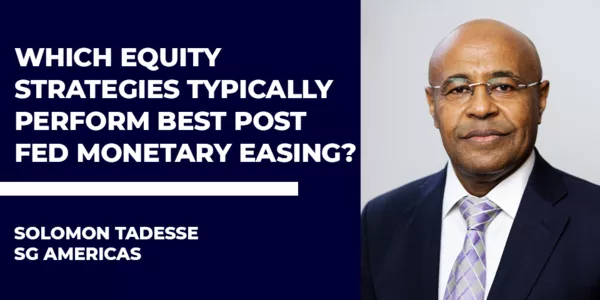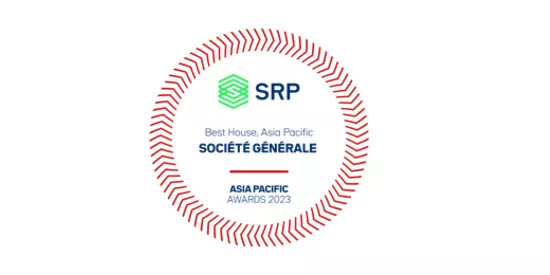
Meet Yann Garnier, Head of Global Markets Sales
SRP Asia recently met with Yann Garnier, Head of Global Markets Sales. He explains how his experiences in Europe and Asia have made him passionate about improving “client service” and how the building blocks to enhance it are all part of Societe Generale’s DNA: cross-asset expertise, understanding of local dynamics, client connectivity and appreciation that the simplicity of the relationship with clients is key.
Article by Richard Jory.
Published in the SRP Asia April 2018 issue.
Click here to download a PDF version of the article.
Click here to access SRP's website.
 Yann Garnier’s ambition was installed in Paris over the 10 years he worked as part of Christophe Mianne’s equity derivatives team, joining Societe Generale in 1998, when Mianne was the pioneering head of equity derivatives. “He wanted to build everything and he had a vision of the distribution of investment solutions to retail investors and wealth management; he also wanted to be the first and most innovative participant in equity derivatives, establishing the bank as ‘the reference’ to the industry,” said Garnier.
Yann Garnier’s ambition was installed in Paris over the 10 years he worked as part of Christophe Mianne’s equity derivatives team, joining Societe Generale in 1998, when Mianne was the pioneering head of equity derivatives. “He wanted to build everything and he had a vision of the distribution of investment solutions to retail investors and wealth management; he also wanted to be the first and most innovative participant in equity derivatives, establishing the bank as ‘the reference’ to the industry,” said Garnier.
Fresh from his legal and business studies, Garnier signed up as a sales assistant, taking calls and preparing marketing pitches. “They were looking for a profile that was not mainstream,” said Garnier. “I didn’t yet know what an equity derivative really was.”
A year later, he moved to the new emerging markets desk as one of the young salespeople travelling Eastern Europe and Mediterranean rim to promote SG - then unknown in the Czech Republic, Hungary and Poland - as well as a new range of products, doing his first deal in Malta.
Nearly a decade later, Garnier swapped experience in Europe for the excitement of a vibrant Asia Pacific market. Buoyed by booming markets, he relocated to Hong Kong in December 2008, just as regulators in Singapore, Hong Kong and Taiwan decided to close their retail structured products market for a review that was estimated to take two months and ended up lasting as many years. “I arrived in Hong Kong to a welcome from 40 retail structured products salespeople and no business,” said Garnier. “In early 2009, there were no deals, nothing, it was super quiet.
“That was my first experience of Asia, and I knew at the time that it was a matter of survival to diversify our business,” said Garnier.
Due to the Lehman Brothers’ Minibond scandal, retail markets would never return to their original form. “We were mostly an equity derivatives and a retail structured products house, and I was here to develop the institutional part; the best way to do that was to embrace the full spectrum of the product offering - fixed income and cross asset and create the cross-asset platform.”
Becoming cross asset changed everything. “We were the pioneer in creating this cross-asset culture, which is an advantage in front of the client, because, instead of pushing products, you become product agnostic and listen and advise,” said Garnier. First mover status helped the bank to attract fixed income and equities talent from across The Street.
“Within a few years, we managed to build a solid and integrated solution factory: we want to provide advisory to institutional clients and, when there are large volumes on any underlying, we want to offer the same consistently on flow and institutional products; and, over time, we’ve managed to build a leading market share on exotic equity, equity derivatives flow, exotic rates - where we were nowhere 10 years ago - and rates flow derivatives,” said Garnier.
Being contrarian on Japan in 2009 also helped. While most banks were shying away, SG saw stable regulation and investors who were savvy and innovative when it comes to derivatives as a reason to localise staff, including an engineering team. “There are a lot of similarities between the French and Japanese in terms of technology and innovation,” said Garnier. “We were also able to say that we were truly committed to Japan, which made a real difference in front of clients, and we were able to build our market share. We were there during the crisis, adding a JGB primary dealership in 2011, and Japanese investors have long memories... We developed a nice franchise in variable annuities, and our distribution business in Japan is nowour largest in the region.”
Two years after establishing itself in Japan, Societe Generale looked to South Korea, the largest derivatives market in the region with the second largest pool of institutional assets. Again, the bank decided to go local. “You need to create a dialogue with the regulator,” said Garnier. As a leader in derivatives, we ought to play a role in educating the market and spending time with regulators explaining what structured products and solutions are and what we deliver, from credit to market risk.
“We decided to go local in every jurisdiction in which we wanted to be in the top three, which means going to see the regulator and apply for additional licences,” he said. “We want to adapt our global offering to comply with local regulations, so we have asked for their advice. Employing locally also means investing locally, so we ask for the support of regulators while assuring them that they can trust us to work alongside them and according to the rules.”
In the less bullish markets of 2011, 2012 and 2013, when investors were looking for alternatives, one answer was longer term products, “our structuring teams developed all the hybrid ranges - a combination of payoffs covering equity, rates, or equity and FX, adding on request a credit component for the most sophisticated investors,” said Garnier. “That lasted for two or three years, when these products benefitted from the rich funding of banks, which were looking to improve their balance sheet... 2015 to 2016 was more about credit-linked notes, reverse convertible on CMS, and income-paying products. Markets were dull and clients were looking to get coupons from a linkage to credit or CMS.
“In Asia, when a product becomes successful, it draws a huge amount of interest and money all of a sudden,” said Garnier. “It’s the case for autocalls, for reverse convertibles on CMS, where we traded from private banks to large institutional investors, or for CLNs. Another characteristic is size: once there is a landmark trade, it is usually repeated, and that’s the story of last year on mutual funds.”
The market in Asia is now more mature, educated and regulated than ever, a trend that will continue, according to Garnier. “To be successful, we need to make sure that we start from what investors are looking for - not only in market exposure (long equity, market neutral, diversified, looking for yield), but also the simplicity of the experience we give to the client,” he said.
“If you improve the customer experience and care about both long-term performance and service quality, the market naturally grows,” said Garnier.
The next challenge and opportunity for the bank is to move from market access to become one of the leaders in client connectivity, which means offering a seamless connection to its product platform to investors from large institutions to third party distributors, according to Garnier. “Connecting to and accessing research reports, viewing and trading product offerings, accessing more sophisticated services - such as simulations, market screening or risk analysis - and getting all post-trade information, such as reports and coupon acknowledgement, and so on,” he said.
“The next frontier is the meaningful development of markets in China,” said Garnier. “The suitability rules are already there for some parts of the market and investors are much more advanced in digitalisation than in any other market. The market size and trading volumes are mind boggling.”




